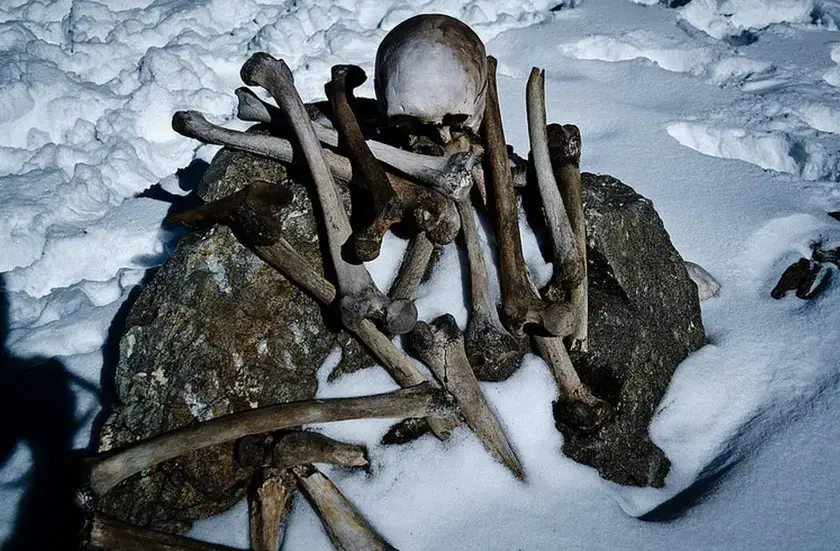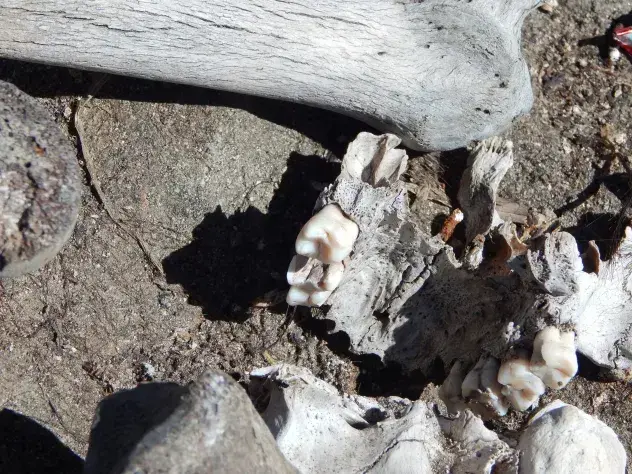Himalayas’ Skeleton Lake: A Rooftop Enigma
A frozen lake known to many as a beautiful tourist destination with picturesque landscapes, situated more than 5,000 meters above sea level on the peak of the Himalayas, is transformed every summer into a completely different spectacle when the ice melts: a mass grave of more than 800 skeletons dating back thousands of years. What happened here?

Roopkund Lake
The place referred to is Roopkund Lake, now called Skeleton Lake, also known as the Skeleton Lake (locals call it the “Mysterious Lake”). It is a glacial lake in the state of Uttarakhand in India, situated in the lap of the Trishul mountain range, and is famous for the hundreds of human skeletons found in the lake.
A ‘horrible scene’
This uninhabited place is located at the bottom of a small valley in the Himalayas at an altitude of about 5,029 metres (16,499 ft). The lake is very shallow, with a maximum depth of about 2 metres, surrounded by glaciers and snow-capped mountains.
It is a natural wonder, making it an attractive and popular destination for adventurous tourists who wish to conquer and admire it. Every May, when the ice melts, the shallow bottom of the lake reveals its true nature with the appearance of hundreds of mysterious skeletons.

Millenary remains on the bed of Lake Roopkund.
In 1942, this amazing mystery was discovered. Over 200 human skeletons were found in one corner of the lake bed when the summer ice melted that year, revealing the remaining skeletons, which floated to the surface and lay scattered across the lake. Something terrible must have happened here, as most of these skeletons were still intact.
Later, further examination and counting revealed that there were over 800 human skeletons of various sizes inside the Roopkund Lake. Immediately, this news spread and created a sensation across the world. Since the Roopkund Lake is uninhabited, the existence of a huge lake of skeletons in the midst of the vast wilderness is truly an astonishing phenomenon.

Millenary remains on the bed of Lake Roopkund.
Many assumptions were made.
These skeletons are very old. Their skin, hair and bones were preserved in dry, cold air conditions, so they remain almost intact. However, no one has yet determined where they came from or how long they have been there.
Nor could anyone imagine what caused more than 800 people to die in one place in this valley. Various hypotheses have been proposed, including an epidemic, a landslide or a mass ritual suicide. For decades, despite extensive research, no one has been able to unravel the secrets of Skeleton Lake.

Millenary remains on the bed of Lake Roopkund.
Some suggested that during the war, these were the remains of Japanese soldiers who died while fleeing to India. The British government immediately formed a group of investigators to determine the truth about these skeletons. However, upon investigation, they claimed that the bones were not those of Japanese soldiers as they were from before the war.
Many British scholars and research teams believed that the skeletons belonged to General Zorawar Singh of Kashmir (the Indian subcontinent) and his men. General Zorawar Singh’s army was thought to have gotten lost and perished in the Himalayas while returning from the Tibetan War in 1841. However, radiocarbon testing of the skeletons in the 1960s refuted this hypothesis.

; Placement: ; Color:
There are also mysterious legends. In ancient times, the king of Kannauj, along with his queen, his sons and his courtiers, ventured into the Himalayas to hold a lavish banquet. The revelry of the king and his entourage offended the goddess Nanda Devi because the Himalayan peaks were sacred and not meant for pleasure. Angered by his sacrilegious actions, the goddess Nanda Devi conjured a huge hailstorm that descended on the arrogant king’s banquet.
Due to the extremely difficult and complex research conditions, most approaches to the huge skeletal lake only involved observing and exploring it when the ice is melting.

Anonymous remains in a cold Himalayan landscape
It was not until 2003 that scientists from the Department of Archaeology at Deccan College in India were able to collaborate with German scientists and the National Geographic Channel in the United States to film and study Skeleton Lake. In 2007, using modern technical equipment, scientists came to conclusions and the mysteries of Skeleton Lake began to be revealed.
the real cause
DNA tests were performed on 31 skeletons, which still had visible heads, hair and nails. These samples were taken to India’s molecular biology research center for examination. After analysis, scientists discovered a strange fact: all of these individuals had small bony protrusions on their foreheads, a feature found only in residents of Maharashtra in south-central India.

Scattered bone remains in Roopkund Lake.
DNA analysis revealed that among the 31 skeletons, 3 samples had a unique genetic mutation that had not been seen anywhere else in the world except among the immigrant group from Maharashtra, India. These three samples had identical mutations, indicating that these individuals belonged to the same family and were residents of Maharashtra, India. Therefore, these people were related by blood.
Furthermore, among the 800 skeletons found in the lake, scientists discovered many interesting details. The 800 skeletons were divided into two main groups: one group consisted of shorter individuals, while the other group consisted of significantly taller individuals. These skeletons date back to around 850 AD, more than 1,000 years ago.

Scattered bone remains in Roopkund Lake.
The final conclusion was that the more than 800 people at Roopkund Lake were Indian pilgrims. The shorter individuals could have been local residents or guides for the pilgrimage group.

Human bones lie scattered at the bottom of the lake.
DNA examination and skull fractures revealed that all of the individuals had died from a fatal blow to the back of the head with a round object the size of a ball. It is hypothesized that an unexpected hailstorm with extremely large stones (possibly travelling at speeds exceeding 160 km/h) occurred, leaving them no time to find shelter, leading to their deaths. Some of them were injured and later died of hunger and cold.
These ancient skeletons remained intact because they were preserved in the ice and snow at the low temperatures of Roopkund Lake. To date, this conclusion is considered the most reasonable explanation.

Over the years, hikers to Roopkund Lake have collected bones for display.
The mysteries of the huge skeletal lake on the roof of the world continue to attract many people. Moreover, Roopkund Lake appears only once a year, which makes it even more attractive for those who wish to explore and witness this unique lake.
As a sacred site where hundreds of people suffered tragic deaths due to a natural disaster, many also consider it a place of prayer, raising concerns about the preservation of the skeletons.
Many tourists visit the site to see the remains and some even take bones with them when they leave. Therefore, efforts are needed to protect this area as an ecotourism site to ensure that the remains are not damaged…






